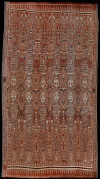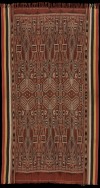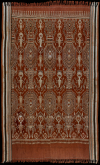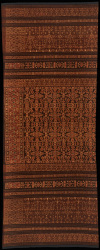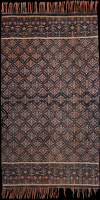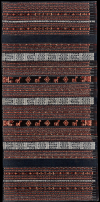Media
Fibres of Life: IKAT Textiles of the Indonesian Archipelago
Following the footsteps of a vanishing craft
14 Sep 2017
(From left) Ribbon-cutting ceremony by UMAG Director Dr Florian Knothe, Collector of Pusaka Collection Mr Peter ten Hoopen and his wife Mrs Ineke ten Hoopen.
The University Museum and Art Gallery (UMAG) will present Fibres of Life: IKAT Textiles of the Indonesian Archipelago from toimorrow (September 15) to November 26, 2017. With the exhibition and the publication of Ikat Textiles of the Indonesian Archipelago, UMAG offers a comprehensive overview of the profusion of ikat styles found across the Indonesian archipelago.
An opening ceremony of the exhibition was held at UMAG today (September 14). Officiating guests included Consul of Information and Socio-Cultural Affairs from the Consulate General of the Republic of Indonesia in Hong Kong Mrs Yuni Suryati, Collector of Pusaka Collection Mr Peter Ten Hoopen and UMAG Director Dr Florian Knothe.
UMAG hopes to contribute to the broader project by means of this exhibition and publication, which shows ikat culture through a close reading of examples from over fifty weaving regions and a brief introduction to the conditions, beliefs and customs of the various peoples who have created and used them. The Pusaka Collection reveals the stylistic spectrum of the archipelago's ikat, while also showing remarkable correspondences rooted in time or sculpted by inter-island cultural exchanges. It is rich in superb and rare ikat textiles, many with few known cognates and some of them probably unique.
Looking at Peter Ten Hoopen’s Pusaka Collection from a scholarly point of view, it is worth acknowledging how it illustrates the concept of ‘unity in diversity’, which the young state of Indonesia chose as its motto upon independence. Here, the interwoven-ness of styles from its islands matter, as do their marked individuality and idiosyncrasies. Moreover, it allows for the study not just of the people’s finery, but also of their daily attire, which is lamentably absent in most collections.
An ironic illustration of the effect of this collecting method comes from Ili Mandiri on Flores. As its dark red bridewealth sarongs have been prized and venerated by the local population, this is what most sophisticated collections have aimed to obtain. The simple but lovely indigo sarongs for everyday use have been almost entirely ignored by collectors. Hence they nearly always end up worn to shreds and very few survive — rarer now than the precious and respected, hence eagerly collected, bridewealth sarongs.
What knowledge is conserved about ikat textiles and their use in the Indonesian archipelago consists primarily of the records of missionary and scientific fieldwork, predominantly compiled by non-Indonesians. The coverage is thin— many weaving regions are covered by only one or two sources, and several regions have never been studied in any detail. Much traditional knowledge is being lost, especially in the more remote island regions in the Indonesian archipelago, which require concerted effort if any trace of their culture is to survive.
Details of the Exhibition
Period: September 15, 2017 (Friday) to November 26, 2017 (Sunday)
Opening Hours:
09:30 – 18:00 (Monday to Saturday)
13:00 – 18:00 (Sunday)
Closed on University and Public Holidays
Venue: 1/F T.T. Tsui Building, UMAG, HKU, 90 Bonham Road, Pokfulam
Tel/Email: (852) 2241 5500 (General Enquiry) / museum@hku.hk
Admission: Free
Website: http://www.umag.hku.hk/en/
Connect with UMAG on social media:
Facebook: https://www.facebook.com/umag.hku
Twitter: https://twitter.com/UMAG_HKU
Instagram: #IKAT, #Textiles, #IndonesianArchipelago, #UMAG
Weibo: @香港大學美術博物館UMAG
About University Museum and Art Gallery of the University of Hong Kong (UMAG)
UMAG was founded in 1953 as the Fung Ping Shan Museum. It was originally established as the Fung Ping Shan Library in 1932 in honour of its benefactor. For more information on UMAG, please click here.
Media enquiries
UMAG Communications Officer Miss Elena Cheung, Tel: (852) 2241 5512, Email: elenac@hku.hk
UMAG Programme Assistant Miss Chelsea Choi, Tel: (852) 2241 5509, Email: cchelsea@hku.hk
Please click here for image captions.
Borneo (Sarawak)
Iban people
Pua, ritual blanket
Warp ikat in medium hand-spun cotton
1935–1950 (Image 75)
Flores (Ende)
Endenese people
Luka semba, men’s wrap
Warp ikat in fine hand-spun cotton
19th or early 20th c. (Image 238)

